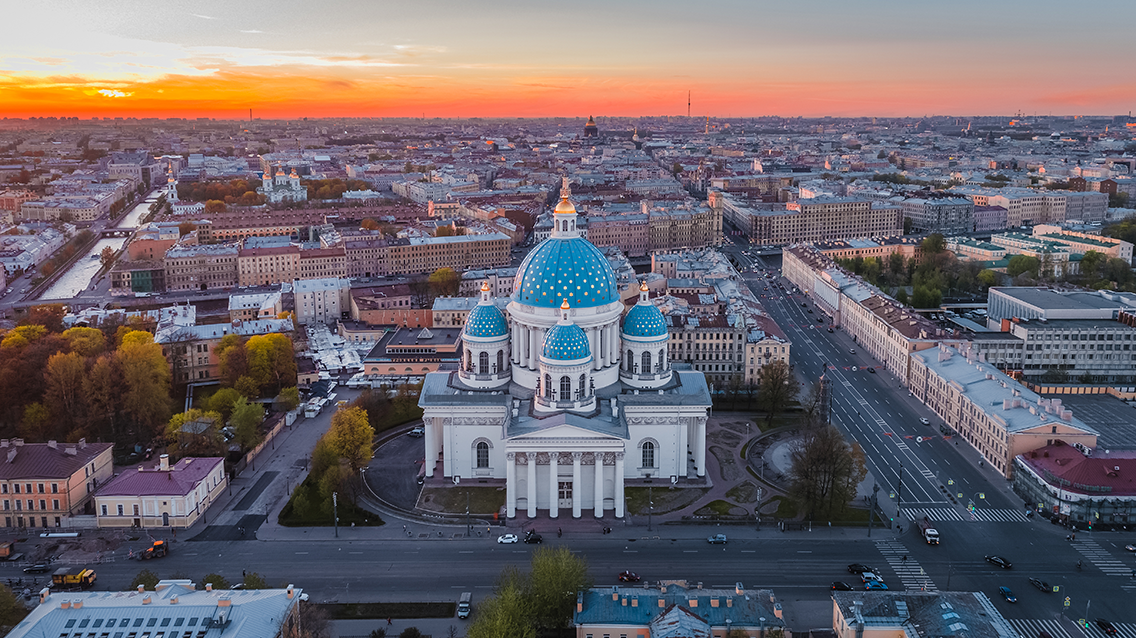 Back
Back
Cathedral of the Holy Life-Giving Trinity of the Life Guards of the Izmailovsky Regiment. (Holy Trinity Izmailovsky Cathedral)

Izmaylovskiy pr., 7A
One of the most monumental churches in Saint Petersburg and a monument of military glory.
Trinity Cathedral in Saint Petersburg is an architectural monument of late classicism. It got one of its names from the name of the Izmailovsky regiment, one of the oldest in Russia. The regiment was founded by Empress Anna Ioannovna in 1730 under the name of the village of Izmailovskoye in the Moscow region. The temple is often called the Trinity-Izmailovsky, as well as «Bulgarian». According to one version, it was built with the money of the Bulgarian people as a token of gratitude to the Russian soldiers for their help in liberation from Turkish soldiers.
The temple was wooden until the beginning of the 19th century; the decision to build a stone temple on the site of the destroyed wooden one was made by Nicholas I. By his order the temple was supposed to accommodate up to three thousand people. Nicholas I, architect V.P. Stasov and engineer P.P. Bazaine took part in the construction. The process progressed slowly as every decision was agreed with the Emperor.
The first stone of the Holy Trinity Cathedral was laid on May 13, 1828, on the feast of Pentecost. The cathedral had been under construction for seven long years and was inferior in size only to St. Isaac's Cathedral, which was being built in St. Petersburg at the same time. The cathedral was consecrated on May 25, 1835, on the eve of the feast of the Holy Trinity.
Trinity Cathedral is a tall white temple with five blue domes, made in the shape of a hemisphere, studded with bronze stars and gilded crosses. According to legend, the color of the domes was chosen according to the color of the uniforms of the Izmailovsky regiment. The main dome of the temple can be seen almost 20 kilometers away. The small domes of the temple are located above the columns of the porticos.
The facades are decorated with four 6-column porticoes of the Corinthian order. Bronze figures of angels are placed in the niches of the western portal. Not far from the temple there is a chapel that has been restored.
The interior of the temple is decorated with Corinthian columns and pilasters covered with white artificial marble. The main dome seems to soar upwards. The walls and vaults were painted by artists T.A. Medvedev and A.I. Travin. The semicircular iconostasis, decorated with Corinthian columns, forms a single whole with the canopy above the altar.
One of the most revered shrines of the Trinity-Izmailovsky Cathedral is the icon of the Holy Trinity, painted in the 15th century.
Since the temple served as the main garrison church of the city, its walls were decorated with Turkish banners - trophies obtained during the battles in the Russian-Turkish war of 1877-1878. In memory of the fallen soldiers, their names were carved on marble plaques. Despite the fact that the temple was a regimental one, the number of civilian parishioners increased here every year. It was here where F. Dostoevsky married A. Snitkina, and the burial service of greatest composer A.G. Rubinstein was held.
With the advent of Soviet power, the fate of the Holy Trinity Izmailovsky Cathedral changed dramatically: it was turned into an ordinary parish church, and the regiment to which it belonged was disbanded. In 1939, the building of the temple was transferred to the Lensovet theatre to be used as a workshop.
The revival of the cathedral began in 1990-2000. The first divine service in it was held on September 8, 1990. The hard and systematic restoration work was interrupted by a terrible fire on August 25, 2006. The fire caused enormous damage to the cathedral. The fire inside the building was prevented, but the wooden central dome of the project of the engineer Bazin, which had served for 170 years, burned down completely. Four small domes were also damaged.
On May 27, 2008, the day of the founding of the Northern capital, the restored small domes of the Holy Trinity Cathedral were opened. On October 9, 2008, a cross was installed on the main dome of the cathedral. This event became a symbol of the revival of the temple. This 9-meter cross became an exact copy of its predecessor, which crowned the temple since 1835 and was destroyed during a fire.



